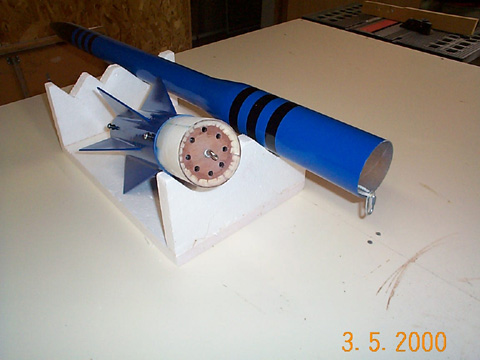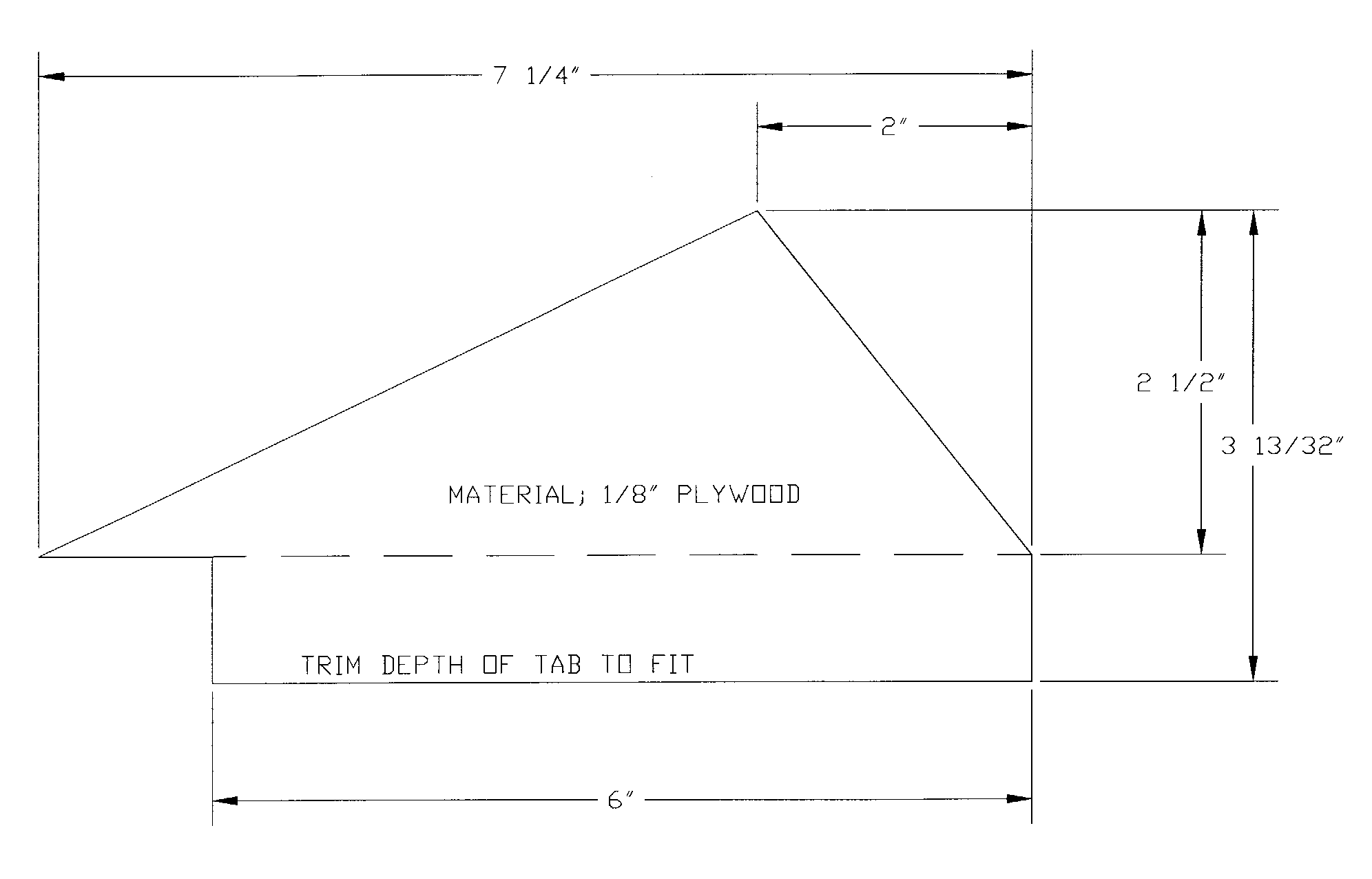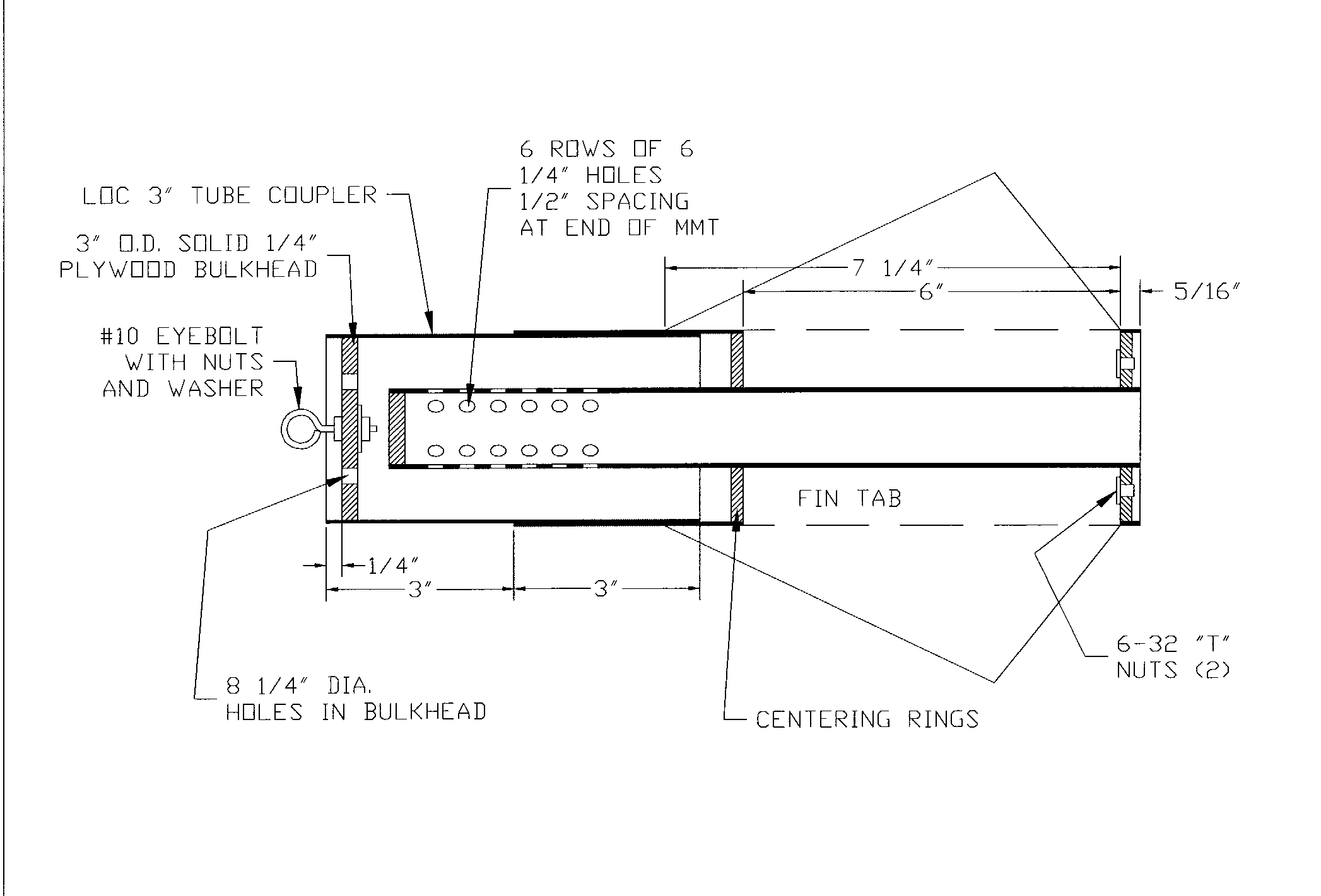| Manufacturer: | Scratch |
 The Blue Blade 3X is the
fourth in a series of Blue Blades I've built. There were a total of 4 with
various motor mount sizes, a 13mm, 18mm, 24mm and the 29mm 3X version.
Unfortunately the 24mm sibling is hanging in a large tree at SMASH's launch
range.
The Blue Blade 3X is the
fourth in a series of Blue Blades I've built. There were a total of 4 with
various motor mount sizes, a 13mm, 18mm, 24mm and the 29mm 3X version.
Unfortunately the 24mm sibling is hanging in a large tree at SMASH's launch
range.
The 3X first flew on an F52-5 with a predicted altitude of 708 feet. The F52 lifted her easily off the pad and she climbed to what I estimate was in the 600 to 700 foot range, arched over and descended less than 100 feet where she deployed the 24" chute. I would have started her out with a larger chute, but it was rather breezy, and the field was a little soft. There was no damage.The second flight was on a G64-7, which promised an altitude in the 1300 foot range. This flight was also picture perfect with deployment a little past apogee.
The Blue Blade 3X's next flight was at the Three Oaks launch in November 1999. Bruce Kirchner graciously loaned me his 29mm-240 RMS for this attempt. Red Arrow was out of my motor of choice, an H128w, so I went with an H238t. Luckily I had brought my set of simulations with more than the H128 and was confident of the motor selection.
I was feeling just a little tense when the Blue Thunder reload roared to life and the next thing I know she's streaking skyward. Rocksim was predicting an altitude of 1837 feet. I could just make out the shape of the rocket against the clouds. I would have to guess that it was a pretty close simulation. The flight was successful and I now have the L1 on my NAR card.
The motor mount tube and the bulkhead in the coupling are designed to function as an ejection baffle while incorporating an anti-zipper design.
Parts list;
- LOC BT-3.00 body tube cut into 2 sections, 10" long
- LOC BT-2.14 body tube 20" long
- LOC PNC-2.14 nose cone
- LOC AR-3.00-2.14 airframe reducer
- Red Arrow RAHPT11 29mm phenolic tube 12" long for motor mount
- 2; 3" O.D. x 2.26" I.D. 3/16" plywood centering rings
- 1; 2.9" O.D. solid *" plywood bulkhead
- 1; 3" coupling. I made the coupling for this bird by slitting a section of the 3" BT and re-sizing it to fit as a coupling. Total coupling length is 6". You could substitute a LOC coupling.
- 1; 1.14" O.D. *" plywood bulkhead/plug
- 2; 6-32 "t" nuts for Kaplow Klips
- #10 stainless eye bolt, #10 stainless hex nuts (2) and (1) #10 sst fender washer
- Launch lug of your choice, *" minimum. I used Blacksky rail lugs.
- Shock cord chute and hardware of your choice. I used 12 ft of *" eleastic and a top flight 24" cute with small quick links to tie it all together.
 These instructions are rather
brief and I am assuming the reader has some mid-power rocketry experience.
These instructions are rather
brief and I am assuming the reader has some mid-power rocketry experience.
First cut the BT-3.00 to the correct lengths. I used a 6" long section of what was left to fabricate the coupling. (I had forgotten to buy one at Red Arrow when I bought the rest of the parts, duh!) I split the 6" section lengthwise and rolled it up and inserted it into a section of tube. I marked the overlap on one end, then pushed it through to the other side and marked the opposite end. I cut the excess tube away and epoxied the tube back together and laid a piece of scotch tape over the outside joint to cover the epoxy. I slid it back into a section of tube and reinforced the slit with the section of tube I had cut away. Be sure to keep the epoxy off the OD of the coupling! Letting the epoxy cure with the coupler in the tube helped it keep a nice snug fit.
Drill 8, *" diameter holes equally spaced into the *" bulkhead plate and one 3/16" diameter hole in the center. The *" holes are on an approximate 1" radius. I attahced the #10 eye bolt at this time to give me something to hold onto when I epoxied the bulkhead plate into one end of the coupling. I positioned the plate *" in from the end and added a healthy fillet and small section of glass cloth tape to reinforce the bulkhead to coupling joint.
Drill the holes in one centering ring for the "T" nuts and epoxy them in place. Mark the 29mm MMT for the centering rings, the rear at 1/8" from the end the other at 6 5/16" from the end. Make a 29mm/1.14" diameter x *" thick plywood bulkhead plate from some scrap. Coat one end with epoxy then epoxy this into one end of the MMT, coated face toward the motor end. I used a strip of *" wide glass cloth electrical tape and epoxy to reinforce the bulkhead. After the epoxy cures drill the 6 rows of 6 *" diameter holes into the bulkhead end of the MMT. Epoxy the forward centering ring so the back surface is at the 6 5/16" mark.
Mark one of the 3" body tubes with 6 fin guides. Off set a mark 1/8" from each for the fin slots. Mark the aft end of the slots 5/16" from the tube end and the other mark at 6 5/16". Cut the fin slots out. I used the little saw attachment in my Ryobi multi-tool.
Epoxy the motor mount into the slotted body tube so the aft end of the MMT is flush with the aft edge of the body tube. Cut out the fins, match sand and round the leading and trailing edges. Make sure the fin tabs match the depth of the body tube to MMT distance and sand to fit. Epoxy the fins in place adding internal fillets in you favorite manner. Keep epoxy off the aft edge of the fin tabs.
Epoxy the aft centering ring into the body tube. I oriented the "T" nuts directly between two of the fins. I also glued in a scrap of 1/8" ply about 1" up inside the body tube. I used this as a reinforced mounting spot for the Blacksky rail lug I would install lalter on. Be sure to mark the body tube location for later reference! Fillet the fins as you normally would. If you go with launch lugs attach them as you normally would.
For the forward section of the 3X I simply epoxied the nose cone into one end and the transition into the other. Seeing that the attachment point of the transition would be inaccessible after it was glued in, I securely fastened a length of 3/16" braided nylon cord to the transition. I had a loop at the other end and the length such that it extended past the back of the upper 3" tube by a few inches. I attach one of the quick links and the shock cord end to the loop. Another quick link attaches the shock cord to the eyebolt of the lower section. The chute is attached to a loop in the shock cord 1/3 of the way along from the lower section. This way the rocket sections shouldn't smack each other on deployment.
I pack the chute into the forward section behind about half of the shock cord first and follow it with the remaining shock cord. So far this method has worked well, as has the baffle incorporated into the coupling and the motor mount tube.
Rocksim gives the Barrowman calculated CP location at 41.59 inches from the nose and the Rocksim calculation CP at 43.35 inches from the nose. I weighed out the 3X at 963 grams less engine. The Blue Blade's Rocksim file can be found in the Rocksim library on the Apogee Components web page.
Sponsored Ads
 |
 |













